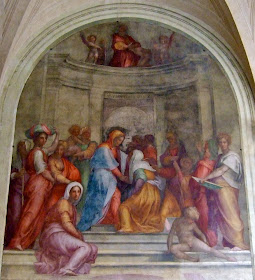In Luke's account of Jesus' birth, you can find
plenty of literary features. There are four hymns and two annunciations,
two births, and two circumcisions. The characters are also paired
together uniquely. They form doublets, running parallel to one another
for readers and listeners to compare and contrast. Zechariah and Joseph
are two fathers who perform their parts silently. Two mothers rejoice
and sing the news: Elizabeth and Mary. The birth of two sons runs
parallel to each other. The birth of John the Baptist anticipates the
role of Jesus. Two sets of messengers spread the news: angels and
shepherds. Two witnesses around the temple offer instructions, blessing,
and warnings when they see the child: Simeon and Anna.
One of the first
artists to depict this motif was one of Leonardo da Vinci's students,
Jacopo Pontormo. In his painting for the atrium of the SS. Anunziata in
Florence, Italy, he paired Elizabeth and Mary with Joseph and Zechariah.
These mothers and fathers (and their sons), bear the promise first
described in Malachi. The messiah would "turn the heart of fathers to
their children and children to their fathers." (Malachi 4:6). Luke
elaborates a bit on that prophecy and states more directly that this
would turn "the disobedient to the wisdom of the righteous--to make
ready a people prepared for the Lord" (Luke 1:17).
These doublets will
shape each of my messages in Advent. We will compare and contrast these
characters to prepare our lives for the coming of the Lord. We will look
at their attributes, habits,
attitudes, difficulties, and emotions. By doing so, we close the gap
between the strange
world of the first century and our world. We realize that through their
emotions, frustrations, and
fears, we share a life that was not meant to be lived in isolation. We
live out the coming of the Lord with friends, parents, children, and
messengers learning how to believe. Through the message of Advent, God
invades each person's life and works in miraculous ways, especially when we share the story with someone else.
Above: Pontormo. Visitation. 1514-16. Fresco. S. Annunziata, Florence.

No comments:
Post a Comment